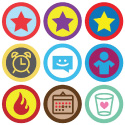 Games are part of peoples’ lives in the 20-teens. Gamification has been used in military and business training and now is a growing method to help change peoples’ behavior across a variety of issues — health, among them.
Games are part of peoples’ lives in the 20-teens. Gamification has been used in military and business training and now is a growing method to help change peoples’ behavior across a variety of issues — health, among them.
But it’s not all “fun and games” when it comes to succeeding in applying gaming methods in health, according to Gaming to Engage the Healthcare Consumer, a report from ICF International.
ICF’s roots are in the defense industry, and the team that wrote this paper together have decades of experience in military applications. These learnings can be quite useful when translated into the health sector.
One key lesson learned: it’s a big sandbox of players that’s required when gamifying health. “Success in this space requires a team of multidisciplinary, multifaceted experts, including advisors in healthcare, instructional design, research, assessment, and game design,” ICF recommends.
What’s driving gamification in health are:
- Outcomes-based medicine, paying for value from volume-based reimbursement
- Consumer-based business models, with people, patients and caregivers vesting (and investing) more in their health and the health of their loved ones
- The maturing of Gen Y, who have grown up with game-based interfaces.
Smart games, ICF says, can be best deployed in several cases for health:
- Health-related apps, tracking observations of daily living
- Nutrition, weight management and obesity tools
- Disease prevention, self-management and adherence for people who have been diagnosed with a chronic condition.
- Mental and behavioral health.
Beyond current formats using simulation and telehealth, ICF forecasts emerging areas for gaming in health including augmented reality, Google Glass, and gesture and sensor recognition.
Health Populi’s Hot Points: ICF makes the point that translating gaming into health applications for driving behavior change is truly a team sport. This is absolutely the case, and two of the players in this sandbox must be explicitly called out – the consumer – patient – caregiver, and the health provider. When the behavior change that’s targeted is the person, she/he must be consulted at Phase 0, and ongoing, for keeping the team user-centered. The same goes for tools meant for clinicians to use.
Too many IT developments in health — in and beyond gamified ones — leave out the end-user until it’s too late – during the commercialization or marketing phase.
Instead, developers must get folks involved from the start. There are many ways to skin that cat – through crowd-sourcing ideas online to conducting focus groups with pioneering patients via online social networks of advocates or caregivers, or working with a live team at an academic medical center. Examples of great efforts on this score are the Center for Connected Health in Boston or the Catalunya Project in Spain with whom IBM works.
This then can lead to peer-to-peer marketing with users ‘selling’ users on successful deployments. We’ve seen early evidence of this through Veterans Administration health apps support among returning soldiers dealing with PTSD and anxiety. It’s a win-win all around.




 I'm in amazing company here with other #digitalhealth innovators, thinkers and doers. Thank you to Cristian Cortez Fernandez and Zallud for this recognition; I'm grateful.
I'm in amazing company here with other #digitalhealth innovators, thinkers and doers. Thank you to Cristian Cortez Fernandez and Zallud for this recognition; I'm grateful. Jane was named as a member of the AHIP 2024 Advisory Board, joining some valued colleagues to prepare for the challenges and opportunities facing health plans, systems, and other industry stakeholders.
Jane was named as a member of the AHIP 2024 Advisory Board, joining some valued colleagues to prepare for the challenges and opportunities facing health plans, systems, and other industry stakeholders.  Join Jane at AHIP's annual meeting in Las Vegas: I'll be speaking, moderating a panel, and providing thought leadership on health consumers and bolstering equity, empowerment, and self-care.
Join Jane at AHIP's annual meeting in Las Vegas: I'll be speaking, moderating a panel, and providing thought leadership on health consumers and bolstering equity, empowerment, and self-care.